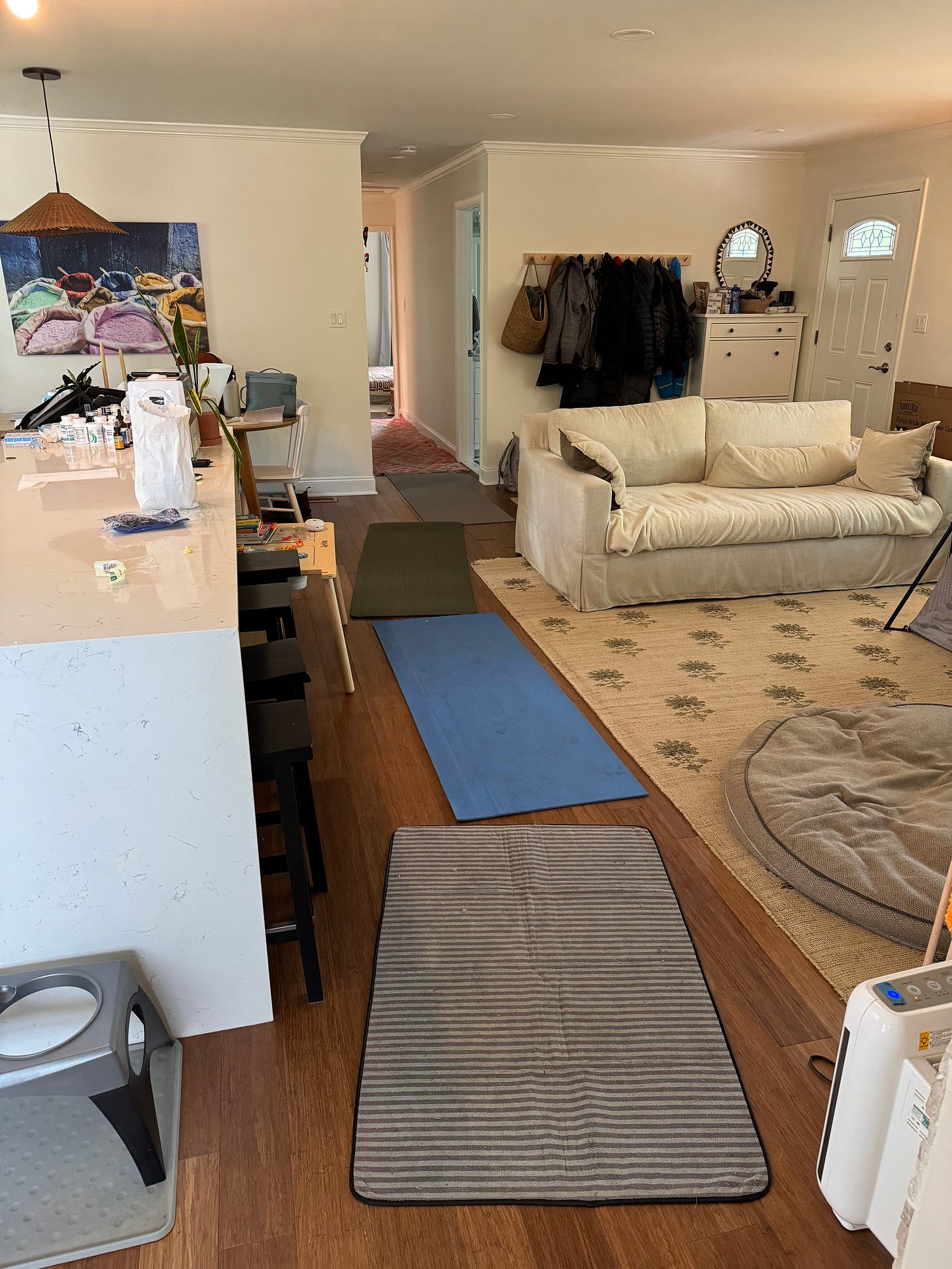I had the pleasure of sitting down with a dear friend and training mentor of mine, Laura Monaco Torelli, to talk about preparing your dog for a surgery or medical procedure, how to get through the recovery, things to think about with emergency situations you don’t have any prep time for, and how to support our dogs after tough experiences at the vet.
You can follow Laura on Instagram and can catch her teaching an online cooperative care seminar this July 19 -20.
Dealing with surgeries and big health events can be incredibly stressful–for both dogs and humans. My dog Otis recently had surgery to remove a large lipoma in his armpit that was impeding his mobility and three other smaller lipomas in other parts of his body. I was lucky enough to get some of Laura’s help before and after the surgery, and I wanted to give all of you a little of the proactive support I found so helpful. This is not a topic I hear talked about often, but one where some extra information can make a big difference for you and your dog. While I hope your dogs are healthy, this is something I think everyone should know a little bit about just in case. If you are going through health stuff with your dog right now, I am sending a lot of love your way. And if you are a trainer, anytime I get to hear how Laura thinks about something, I know my clients are going to be better off for it.
How to Prepare Your Dog and Yourself for Planned Surgeries and Procedures
Consider the timing of the scheduled procedure. Laura recommends, when possible, avoiding procedures on Fridays if the office is closed over the weekend. She also prefers appointments earlier in the day. By doing this, you have greater ability to contact the care team that knows your dog if anything goes wrong when you bring them home. She also mentioned thinking about holidays.
Discuss medication management – should it be dosed? How should it be dosed? Ask the vet about PVPs (pre veterinary pharmaceuticals). For example, if your dog is on regular medication to manage an ongoing health concern, you will want to coordinate closely with the vets involved. This means talking to all the vets involved about the medication plan with the upcoming anesthesia. Laura’s dog Vito had to take seizure medication before surgery, but they wanted him fasted for surgery–this required some coordination. (Laura also mentioned a tip from a vet behaviorist to consider trialing meds for the first time at home rather than at the vet so you can better understand your dog’s behavior.)
Write out what the pre-surgery and post-surgery care is going to look like. Ask your vet ahead of time what the post-surgery care is going to look like so you can prepare for it. For example:
What care will I need to provide at home?
Will I need to apply ice or heat to the sites?
Will the sutures dissolve or be removed?
If my dog gets razor burn, is there anything I can have on hand ahead of time so I am not scrambling to buy something when my dog is uncomfortable?
Not care related but still a potential question: What are the standard operating procedures for dogs coming out of anesthesia? Laura said that over the years, she’s asked if it’s an option to sit with her dog in an exam room as they continue to come out of the anesthesia so they wake up to your presence (she even brings blankets from home). She did mention first being honest with yourself about if you have the emotional bandwidth to do this.
Once you have an idea of what the care will look like, you have the option to prep your dog for some of it. For example, you could practice icing ahead of time. I ran out of time to do this with Otis, but you can see how I eased him into it in the moment in this Instagram post (you could do this same thing ahead of the actual surgery).
Also, if your dog is going to need to wear a recovery cone, I highly recommend making sure your dog is comfortable with one ahead of time. Otis used to be terrified of cones (would literally exit a room if one showed up), and I can’t tell you how grateful I was that I worked on this four years ago and didn’t have that added stress post surgery. Here is an Instagram post showing some ways you can break down cone training (that is really the key – breaking it down and starting where desired behaviors are showing up).
Prepare your dog’s recovery environment. For example, are the floors non-slip? Are there a variety of rest options on the floor if jumping is to be avoided? Are there any spaces that need to be blocked off?
Otis typically sleeps on the guest room bed, so we actually put the mattress on the floor during his recovery. We also put a bunch of yoga mats on any parts of the floor that were not carpeted. We also got a baby gate that we could use to either keep him in one area or keep others in the house away from him without having to always close doors.
If you have a multi-dog household, consider how this recovery may impact the normal flow between the dogs.
For example, Sully is often out in the yard during the day, and can be playful when Otis comes out to potty. I couldn’t have her playing with him, so I had to make sure she wasn’t out free in the yard when I took Otis out for short potty breaks.
Consider the flow of the rest of the house–especially if you have kids. Consider how you can talk to your children about this. What parts of the day are going to feel different or be interrupted? Do you have management options to keep kids from reaching your dog while they are resting post-surgery? Are there dog walkers who usually come?
I shared a bit about how things played out with my son and Otis in the video.
If possible, block off early days post-surgery so you can be with your dog and find your rhythm in your care-taking.
One thing that helped us was that my husband worked from home for a week from our guestroom, so Otis could lie in bed all day with Ben present and not be bothered by a small child (aka he wasn’t locked in a room by himself all day, everyday).
Lean into your community for support. It’s okay for something to be hard for you. I knew dropping Otis off at the vet was going to be a big struggle for me, so I asked Ben if he could drop him off and I would pick him up. Laura reminded us that we can ask for that help without punishing ourselves for needing it.
Community support can also be helpful in early recovery days. If possible, it’s good to have someone present with the dog at all times. If you have a partner, friends, well-known dog walkers or sitters, you can reach out for some help to get the first few days covered if needed.
Consider working with a trainer ahead of time to come up with the pre and post surgery plan. Even knowing what I know about behavior and training, I still found it invaluable to have someone else who wasn’t as emotionally drained with all of it helping me think through things.
Be prepared to hear your dog moaning or not feeling great coming out of anesthesia. We don’t always know how they’re going to feel post-surgery. Know that your dog may struggle with elimination or other things, might have accidents, etc.
Ask your vet team about the general trend for recovery for the type of procedure your dog will be having. What are some of the things we should keep an eye out for? What are some of the things I might not have thought about but that you’ve seen with your clients over the years?
For example, Otis had a drain, and I asked the vet about trends in how much liquid to expect to be emptying in a given 24 hour period and how that is expected to change as the days wore on (I was glad I asked so I wasn’t panicking about just how much liquid it was). I asked them what things I might see with the drain that should alert me to call them.
What does the “as needed” in the phrase “give medication as needed” mean? Consider taking videos to send to your vet showing their behavior if you aren’t sure.
I’ll be frank here: I chose to give Otis basically the max dosage for his pain meds because I didn’t want the pain to secretly creep up. Towards the very end of the two weeks with the stitches, I saw a very obvious shift in his behavior and scaled back on the medications he was still on (some of them were only given for the early days, so there wasn't much remaining).
Consider a way to track your post-op care, so you aren’t trying to manage it all in your head. I originally thought I would track it all in a google sheet on my phone, so my husband and I could both check things off and see who had done what, but I wound up going old school: I printed out a table with checkboxes and taped it to the wall every morning. The spreadsheet had the exact times that medications should be given, icing sessions done, drain emptied etc., so I didn’t have to do math. Time math is hard when stressed.
Ask about what you might be able to shift to make things easier on surgery day. In the past Laura has asked if she could bring her dog in a day ahead of surgery to get weighed so she could use treats and if that weight would be accepted as the pre-surgery weight (since treats often aren’t permitted before surgery, this eliminates the need to get a weight done without treats).
You are an expert on your dog. If you notice something, ask your vet about it. And you can keep politely asking until you have the answers you need.
Think about how you will get your dog into and out of a car post-surgery and how they will travel in the car. I regret not getting a ramp for Otis and training it ahead of time (I will be getting one and training it to avoid this situation in the future). Otis wasn’t allowed to jump into the car (I don’t think he even could have made the jump), but lifting an 85 pound dog with four different incisions by myself was a … challenge. And then I had the challenge of him fitting in the car with a cone and trying to have him lie down in a smaller space with a drain in. Laura said that she sometimes calls the vet office ahead of time to ask if someone can walk out with them to make sure the dog is settled okay into the car.
Also consider if your dog could be a flight risk if they don’t have their normal gear on post-surgery (sometimes the incision sites mean that your dog’s usual harness isn’t an option).
How to Prep Your Dog and Yourself for Medical Emergencies
One tip Laura gave was to find someone–a family member, friend, neighbor–to drive with you to the vet so one person can drive and the other person can watch the dog.
If your dog needs some emergent care and isn’t opting in and you’ve had no time to practice, Laura said to consider asking your vet if you can bring your dog in and have them provide the care while you continue to work on doing it collaboratively. You can also talk to your vet about whether there are any ways to be a bit flexible (while still following the plan) to make the care a bit more palatable for your dog–for example, give less of the dose, titer it, water it down, etc.
Laura recommends having a written plan for your dog ready (digital and printed) and having an emergency vet on deck. For example, Laura would include in her written plan that her dog Vito struggled with other dogs so she asked them to keep him away from other dogs. That way in an emergency, she could hand her dog over for the vet to handle the emergency and know that they had the basic info they needed.
How are you supposed to make vets a “happy place” when dogs have such tough experiences there?
Listen to this episode with a 7-day free trial
Subscribe to Tails of Connection's Substack to listen to this post and get 7 days of free access to the full post archives.














